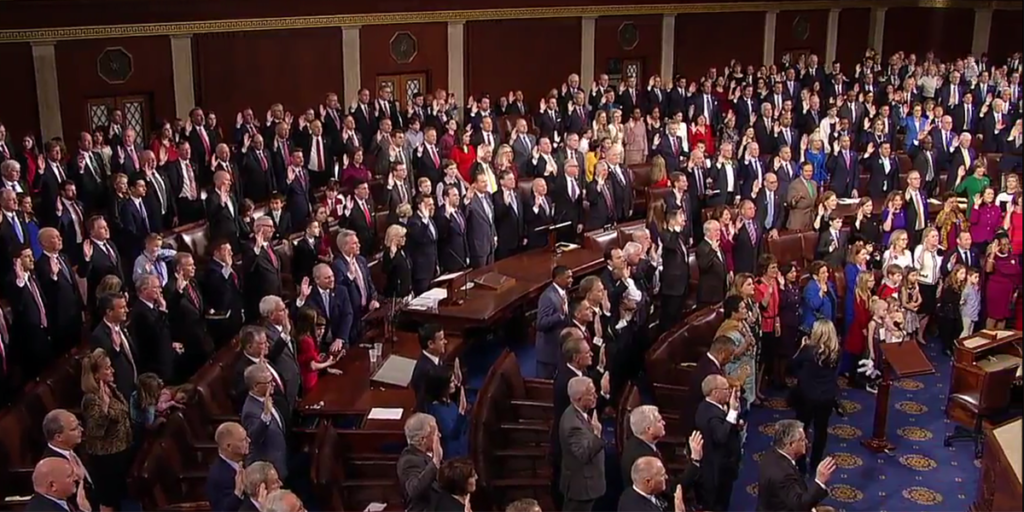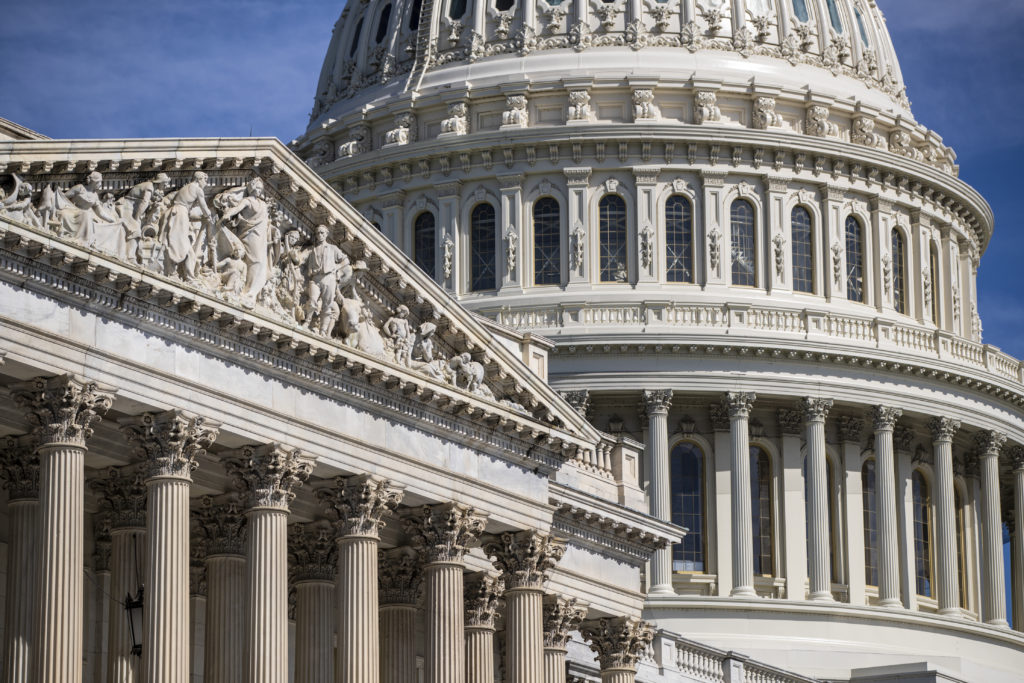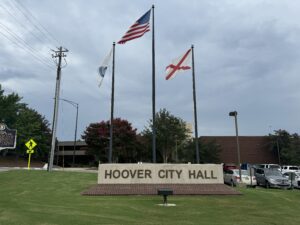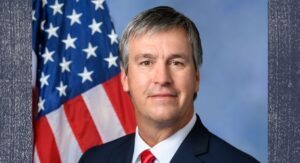Alabama’s delegation sworn in for 116th Congress

Alabama’s nine federal lawmakers — two Senators and seven Representatives — took their oaths of office Thursday as the 116th Congress got underway. Here’s what they had to say about their swearing-in: U.S. Sen. Richard Shelby: As we begin the 116th Congress, I look forward to continuing to serve the American people and welcome my eight new colleagues in the Senate. Let’s get to work! #116thCongress 2nd District U.S. Rep. Martha Roby: I am honored and deeply humbled to represent Alabama’s Second District in Congress and serve as a voice for our shared conservative priorities. With every vote I cast, my guiding principle is that Alabama always comes first. From supporting Maxwell-Gunter Air Force Base and Fort Rucker to improving veterans’ health care and advancing smart agriculture policy, I will continue to fight for the issues that impact Alabamians. 5th District U.S. Rep. Mo Brooks: As the 116th Congress begins its work, I am deeply honored to again have the opportunity to serve the people of Alabama’s Fifth Congressional District. As a Congressman, I have fought hard to defend the foundational principles that have made America the greatest nation in world history. I will continue to fight for those values in the face of stiff and majority-controlling Socialist Democrats in the 116th Congress. In particular, I will work to rein in out-of-control Washington spending, secure America’s borders and elections, defend free-enterprise policies from a strong and dangerous but naïve Socialist agenda, while also promoting strong national security and technological advancement NASA promotes for the benefit of all. The prosperity and freedom of America’s future generations is at stake. I appreciate the trust citizens of the Tennessee Valley have placed in me, and I look forward to a fifth term in the U.S. House. 6th District Rep. Gary Palmer: It was a great honor and privilege to stand on the House floor for the third time and pledge to support and defend the U.S. Constitution,” Palmer said. “I look forward to continuing to serve the people of Alabama’s Sixth District in Washington and pursuing sound policies for the good of the country during the 116th Congress. There is much to do over the next two years and I am eager to get back to work. 7th District U.S. Rep. Terri Sewell: I am deeply honored to represent the constituents of Alabama’s 7th District here in the House of Representatives. As Democrats take the majority in the 116th Congress, we have work to do advancing priorities from wage growth to infrastructure investment to affordable health care. American voters have also made democracy reform a top issue, and in the new Congress I hope to secure broad support for passage of the Voting Rights Advancement Act, a bill which strengthens voter access to the polls and combats discrimination in our elections. Today I am deeply moved to see the most diverse Congress in history sworn into office. We deserve a Congress that reflects the diversity of the American public, and last year I fought to break down barriers for women and working candidates running for office. The 102 women who were sworn into the House today are a testament to the power of the women who have marched, protested, and voted for their seat at the table. Watch the full House swearing-in ceremony below:
Alabama pension fund now sole owner of local newspaper chain

Alabama’s employee pension fund, with about 350,000 members and some $40 billion in managed assets, has become sole owner of one of the largest chains of local U.S. newspapers, the company said Thursday. CHNI LLC has been acquired by the Retirement Systems of Alabama, the company announced in a statement. The newspaper group includes 68 daily newspapers and more than 40 non-dailies plus websites in 22 states. The Montgomery, Alabama-based newspaper group is being spun off Raycom Media Inc., which is being purchased by the Atlanta-based Gray Television Inc. Raycom was owned by the retirement system. CNHI, which began as a small newspaper group in 1997 and previously operated with the state retirement system as its creditor, will gain stability through the acquisition, chief executive Donna Barrett said in the statement. “We are very excited about working with RSA again because of its dedication to the crucial role of newspapers in keeping the public informed on what is happening in their communities and beyond,” she said. Among CNHI’s newspapers are the Valdosta Daily Times in Georgia, The Tribune Star in Terre Haute, Indiana, the Gloucester Daily Times in Massachusetts, The Meridian Star in Mississippi and the Niagara Gazette in Niagara Falls, New York. Financial details weren’t announced. Alabama’s pension fund has other non-traditional investments including golf courses, airliners and the largest office building in New York City, 55 Water. Gray Television, which began as a regional broadcaster, owns or operates stations and digital properties in 91 television markets nationwide with the acquisition of Raycom Media. Republished with permission from the Associated Press.
Steve Marshall calls on Congress to fully fund Donald Trump’s border wall

Alabama Attorney General Steve Marshall isn’t mincing words — he wants the new Congress to fully fund President Donald Trump‘s border wall with Mexico. On Thursday, Marshall called on the new Congress to fully fund a border wall to protect Americans and uphold the rule of law. He also criticized incoming U.S. House Speaker Nancy Pelosi for deliberately ignoring border security by pushing a budget plan that funds every remaining federal agency for the balance of fiscal 2019 except for the U.S. Department of Homeland Security. “It is the fundamental role of government to provide for the safety and security of its citizens and yet many in Washington, D.C., shirk this basic duty in order to score political points,” said Marshall. “Shame on them and shame on Speaker Pelosi for turning a blind eye to continued security threats to Americans by refusing to fund a border wall and the vital operations of U.S. Homeland Security. Marshall continued, “As Alabama’s Attorney General, I am deeply troubled by the steady stream of dangerous illegal drugs entering my state and the impact it has on our citizens and law enforcement. Drug trafficking, human trafficking and many violent crimes committed in Alabama can be traced to criminal elements crossing our country’s borders and the failure of current efforts to secure our border.” Marshall made the request less than a day after news broke that a previously deported illegal immigrant was charged with first-degree rape of a juvenile in Alabaster, Ala. “This week, we learned that a criminal alien previously deported for drug crimes illegally reentered the country—even returning to Alabama where his original crimes were committed—and was charged with the rape of a minor. Where does it end? When does it end? It ends with a border wall as the backbone of a serious and effective border-security strategy that protects Alabamians and all Americans.” Attorney General Marshall participated in a White House panel on protecting America’s borders in August 2018.
Day 13: New Congress, same old impasse over Donald Trump’s wall

The partial government shutdown entered a 13th day Thursday with House Democrats prepared to pass their plan to reopen government and President Donald Trump accusing them of playing politics with an eye on the 2020 election. Both sides appeared at an impasse over Trump’s demand for billions of dollars to build a wall along the U.S. border with Mexico. Congressional leaders will meet with Trump on Friday to try for a resolution. The new Congress convenes Thursday with Democrats taking majority control of the House, and Democratic leader Nancy Pelosi, expected to be elected speaker, said they’d quickly pass legislation to re-open the government — without funds for Trump’s border wall. “There is no amount of persuasion he can use” to get her to fund his wall, Pelosi said in an interview airing Thursday on NBC’s “Today” show. She added: “We can go through the back and forth. No. How many more times can we say no?” Trump shot back Thursday, accusing the Democrats of playing politics. “The Shutdown is only because of the 2020 Presidential Election,” he said on Twitter. “The Democrats know they can’t win based on all of the achievements of “Trump,” so they are going all out on the desperately needed Wall and Border Security – and Presidential Harassment. For them, strictly politics!” The Democratic package to end the shutdown would include one bill to temporarily fund the Department of Homeland Security at current levels — with $1.3 billion for border security, far less than Trump has said he wants for the wall — through Feb. 8 as talks would continue. It would also include a separate measure to fund the departments of Agriculture, Interior, Housing and Urban Development and others closed by the partial shutdown. That measure would provide money through the remainder of the fiscal year, to Sept. 30. The White House has rejected the Democratic package, and Republicans who control the Senate are hesitant to take it up without Trump on board. Senate Majority Leader Mitch McConnell called it a “total nonstarter.” Trump said ahead of his White House session with the congressional leaders that the partial shutdown will last “as long as it takes” to get the funding he wants. In public, Trump renewed his dire warnings of rapists and others at the border. But when pressed in private Wednesday by Democrats asking why he wouldn’t end the shutdown, he responded at one point, “I would look foolish if I did that.” A White House official, one of two people who described that exchange only on condition of anonymity, said the president had been trying to explain that it would be foolish not to pay for border security. “Could be a long time or could be quickly,” Trump said during lengthy public comments at a Cabinet meeting, his first public appearance of the new year. Meanwhile, the shutdown has closed some parks and leaving hundreds of thousands of federal employees without pay. Democrats said they asked Trump directly during Wednesday’s private meeting held in the Situation Room why he wouldn’t consider their package of bills. One measure would open most of the shuttered government departments at funding levels already agreed to by all sides. The other would provide temporary funding for Homeland Security, through Feb. 8, allowing talks to continue over border security. “I said, Mr. President, Give me one good reason why you should continue your shutdown,” Senate Minority Leader Chuck Schumer said afterward. “He could not give a good answer.” At another point Wednesday, Trump told Pelosi that, as a “good Catholic,” she should support the wall because Vatican City has a wall, according to a congressional aide. Trump has mentioned the Vatican’s centuries-old fortifications before, including at the earlier Cabinet meeting. But Democrats have said they don’t want medieval barriers, and Pelosi has called Trump’s proposed wall along the U.S.-Mexico border immoral. “I remain ready and willing to work with Democrats,” Trump tweeted after the meeting. “Let’s get it done!” House Republican leader Kevin McCarthy said that there’s no need to prolong the shutdown and that he was disappointed the talks did not produce a resolution. He complained that Democrats interrupted Homeland Security Kirstjen Nielsen as she was trying to describe a dreadful situation at the border. White House spokesman Hogan Gidley said on Fox that Pelosi will be “more able to negotiate” once she is elected speaker, as expected Thursday. The two sides have traded offers, but their talks broke down ahead of the holidays. On Wednesday, Trump also rejected his own administration’s offer to accept $2.5 billion for the wall. That proposal was made when Vice President Mike Pence and other top officials met at the start of the shutdown with Schumer, who left saying they remained far apart. On Wednesday Trump repeatedly pushed for the $5.6 billion he has demanded. Making his case ahead of the private afternoon session, Trump said the current border is “like a sieve” and noted the tear gas “flying” overnight to deter arrivals. “If they knew they couldn’t come through, they wouldn’t even start,” he said at the meeting, joined by Cabinet secretaries and top advisers, including Jared Kushner and Ivanka Trump. With no negotiations over the holidays, Trump complained he had been “lonely ” at the White House, having skipped his getaway to Mar-a-Lago in Florida. He claimed his only companions were the “machine gunners,” referring to security personnel, and “they don’t wave, they don’t smile.” He also criticized Pelosi for visiting Hawaii. She responded Thursday, saying, “The president may not know this, but Hawaii is part of the United States of America.” She says she was available on 24 hours’ notice. The partial government shutdown began on Dec. 22. Republished with permission from the Associated Press.
Airbus to build additional aircraft on Alabama coast

Airbus says it will fulfill two new aircraft orders at an expanding manufacturing operation on the U.S. Gulf Coast. The European aircraft maker said Thursday that 120 passenger aircraft ordered by JetBlue Airways and the start-up airline Moxy will be built in a new factory near the company’s existing plant in Mobile, Alabama. The company says construction on the plant will begin later this month. JetBlue and Moxy each ordered 60 of the A220-300 aircraft manufactured by Airbus. The plant will be located beside a factory where Airbus already produces the A320 aircraft in Mobile. Airbus produced its first airplane on the Alabama coast in 2016. The new A220 line in Alabama is in addition to one the company is opening in Mirabel, Canada. Republished with permission from the Associated Press.
Daniel Sutter: Are our highways less safe?

Highway fatalities have increased from under 33,000 in 2014 to 37,461 in 2016, before declining slightly in 2017. Many have speculated whether drivers distracted by smart phones have caused this increase. Before further restricting driving, we should examine the problem. The recent increase in fatalities is unsettling because driving has become safer over time. Fifty years ago, over 50,000 Americans died annually on the highways; the worst year was 1972 with 54,589 deaths, according to the National Highway Traffic Safety Administration (NHTSA). Vehicle miles driven have increased dramatically as the death toll has fallen. Indeed, fatalities per mile driven have fallen by 80 percent since 1966. If we still had 1966’s fatality rate with today’s 3.2 trillion miles driven, we would have had 176,000 highway deaths in 2017. Has driving truly become more deadly since 2014? The increase in fatalities might seem to answer this in the affirmative, but real world data never lies exactly on a smooth curve. Could the recent increases in fatalities just be random variation? The two largest year-to-year percentage increases in highway fatalities were in 2015 and 2016, a total 14 percent increase. And yet multi-year fatality increases have occurred since 1966, including four consecutive years in the late 1970s and five consecutive years in the 1990s. The 1970’s fatalities increase was 15 percent. The recent increase in fatalities is not entirely unprecedented. Thankfully, a very small percentage of accidents produce fatalities. If roads are more dangerous, we should also see increases in injuries and accidents. NHTSA injury totals go back only to 1988 and are much less accurate than fatalities data. Still, reported injuries increased 34 percent, or 800,000, between 2014 and 2016, including a 28 percent increase in 2016. The largest previous one-year increase in injuries was only 6.5 percent. Reliable nationwide totals on accidents are not available. Not all states have seen fatality increases. In Alabama fatalities rose 26 percent between 2014 and 2016. Rhode Island had a 63 percent increase in fatalities, and eight other states saw increases of 30 percent or more. Yet fatalities declined in three states and increased less than 5 percent in four more. Are cell phones more distracting in some states than others? Substantial differences in fatality rates exist across states. Between 2014 and 2017, South Carolina’s rate was more than two and a half times higher than Massachusetts’. Factors like rural vs. urban driving, highway type, and speed limits explain much of this variation, but making driving in all states as safe as in the safest states could save thousands of lives annually. The NHTSA also reports fatalities by vehicle type, which have increased by 12 and 13 percent for cars and light trucks. Motorcyclists and bicyclists (15 percent each) and pedestrians (22 percent) saw larger increases, even though drivers of cars and trucks seem more likely to be distracted by cell phones. The fatality increases for cyclists and pedestrians suggest another cause, or may combine drivers’ distractions and these individuals’ vulnerability. Cell phone use and texting have been around longer than we perhaps remember; Washington state banned texting and driving in 2007. According to NHTSA statistics, drivers’ cell phone use has fallen over the past decade, and fatalities fell 20 percent nationally between 2007 and 2014. New phones provide more ways to distract drivers, but why did cell phones start increasing fatalities only in 2015? Many scholars from different disciplines study highway safety, including yours truly. To date, published research has not really addressed the recent jump in fatalities. World events drive academic research, so research should soon start offering concrete insights. Highway fatalities continue to impose a heavy toll on the U.S. Even though the fatality rate has fallen 80 percent since 1966, the modest increase in fatalities since 2014 should concern citizens and experts. Fortunately fatalities fell 3 percent during the first half of 2018. Perhaps the increase from 2014 to 2016 was only a pause in the long-term improvement in highway safety. Daniel Sutter is the Charles G. Koch Professor of Economics with the Manuel H. Johnson Center for Political Economy at Troy University and host of Econversations on TrojanVision. The opinions expressed in this column are the author’s and do not necessarily reflect the views of Troy University.


